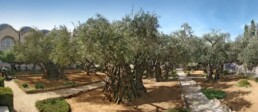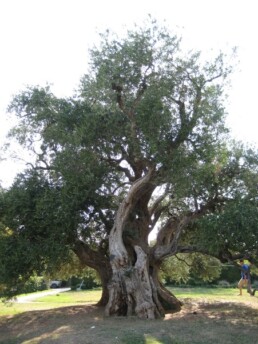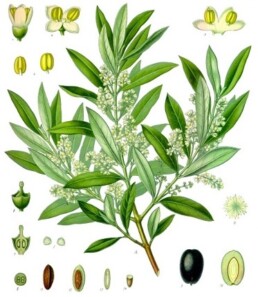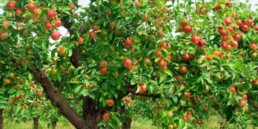12 – Olea europaea / Olive Tree
I am sure if we all looked in our kitchen cupboards today, we could find Olive Oil of some description and think nothing of it. Extra Virgin, Virgin, Olive, or Light Olive. It would really be up to personal preference or the price you are prepared to pay. But what really is Olive oil and what does it come from?
Olea europaea Olive Tree
This is an evergreen tree native to the Mediterranean, It is short and squat, and rarely exceeds 30 ft in height. The silvery green leaves are oblong, measuring 2–4 in long and 0.5 – 1 in wide. The trunk is typically gnarled and twisted.
The small, white, feathery flowers are borne generally on the previous year’s wood, in groups springing from the axils of the leaves.
The fruit is grape like up to 1 in long, thinner-fleshed and smaller in wild plants than in orchard cultivars. Olives are harvested in the green to purple stage.
An extremely slow-growing plant, with its roots even penetrating rock, the olive tree requires years of patient labour to reach full fruitfulness. Being well-suited to grow in the Mediterranean climate, the olive tree plays a significant role in the region’s economy. Olive wood is extraordinarily strong, does not rot, and excellent for building. The outer, fleshy part of the oval-shaped fruit is what yields the highly valuable commodity of olive oil. Still today, olive oil is considered good for health.
The olive tree is mentioned frequently in the Bible, from as early as the time of the flood when the dove from the ark brought an olive branch back to Noah, to Rev.11 v 4, where the two witnesses are represented as two olive trees. In Neh.9 v 25, we see that olives were used as essential food, for lamp oil in Ex. 27 v 20, medicine in Is.1 v 6; Luke 10 v 34, for anointing oil in 1 Sam.10 v 1 & 2 Kings 9 v 3, and sacrificial oil in Lev. 2 v 4 & Gen. 28 v 18, with the trees providing wood for furniture in 1 Kings 6 v 23, 31 – 33. I could go on, but it is the anointing oil I wish to concentrate on. Throughout the Old Testament Gods Holy Spirit is represented by the oil of the olive tree.
Being a very long-lived tree plus the trees ability to live on bare rock and through carbon dating technologies 4 of the Olive Trees that Jesus prayed among in the Garden of Gethsemane before he went to the Cross have been proven to still grow there.
The process by which olives are beaten and crushed to produce olive oil contains spiritual significance as well. Jesus Christ was beaten and crushed on the cross so that His Holy Spirit would be poured out on the church after His ascension to heaven. It is not mere coincidence that Christ’s agonized prayer, “Let this cup pass from me, nevertheless, not My will but Thine be done” occurred in Gethsemane, a place of many olive trees and whose name means “olive press.”
We have just celebrated “Penetcost” the great Christian festival when we celebrate the arrival and pouring out of anointing power of the Holy Spirit upon all flesh. This became a reality because of what Jesus went through for you and all of mankind because of his love for us.
So, the next time you dress your salad, grease your pan, or put olives on your pizza, remember, Jesus loves you the same yesterday today and forever, and if you have forgotten that just say hello, he hasn’t forgotten you.
The gallery below shows:
- Botanical Drawing of Foliage
- 500-year-old Olive tree
- Garden of Gethsemane showing what is reputed to be one of the four trees that Christ prayed among.






